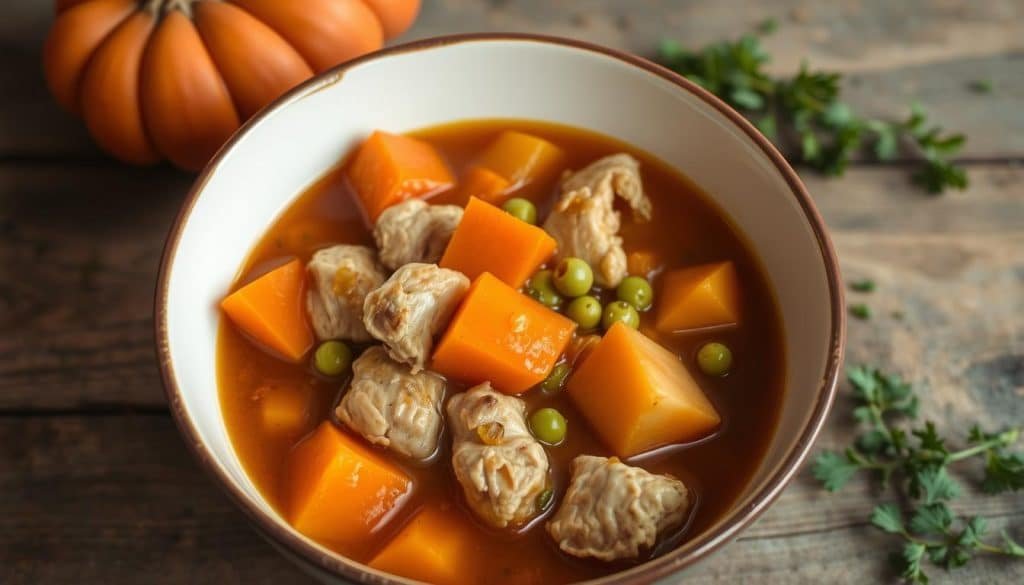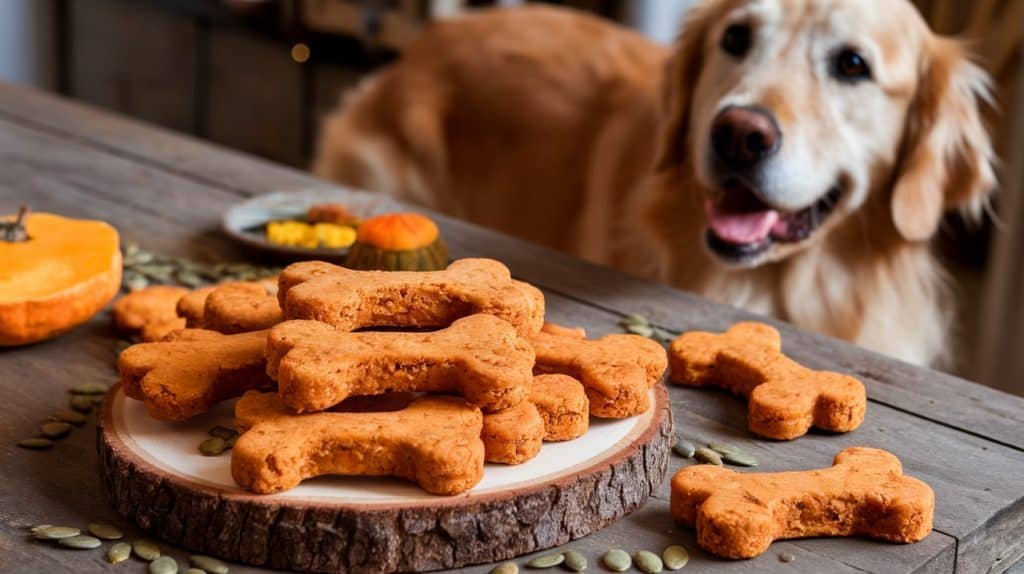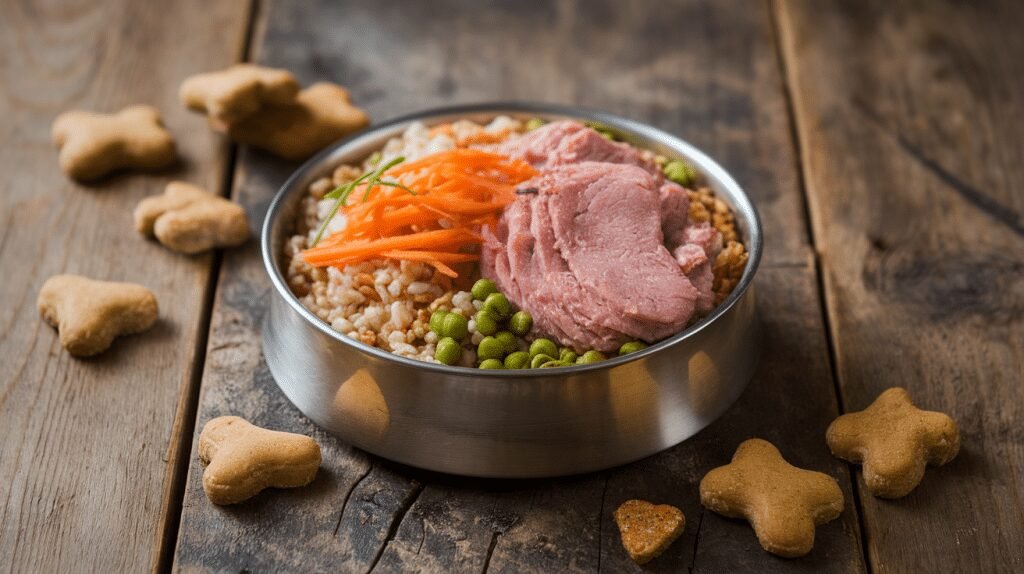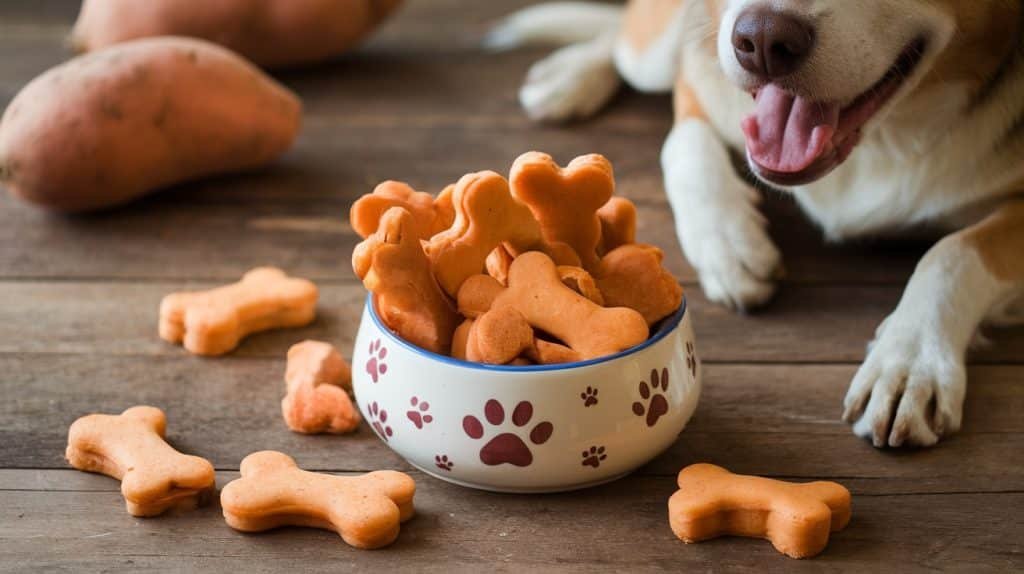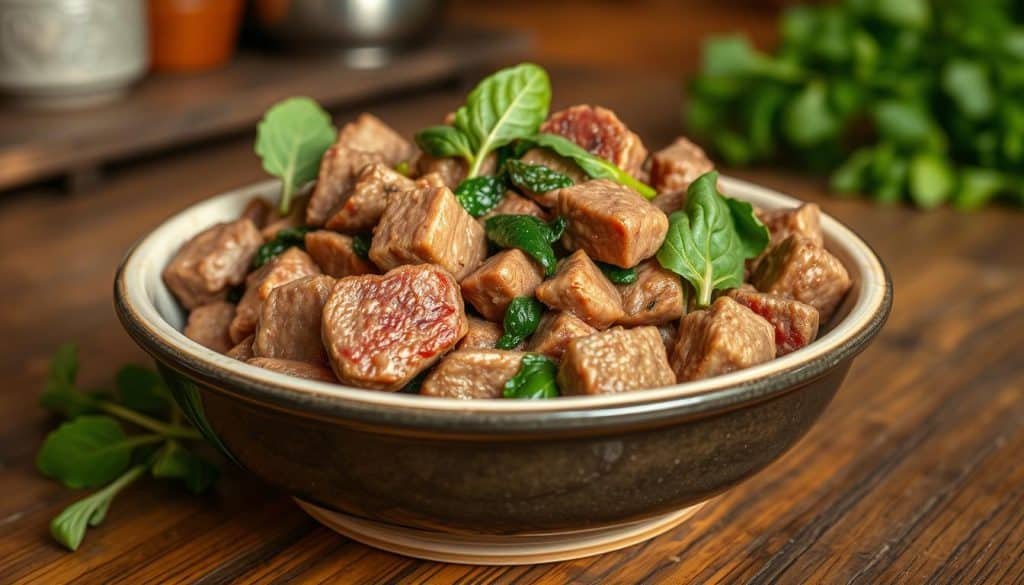
Seeing my dog’s face light up when I give him homemade chicken and pumpkin stew is priceless. Last fall, I started making homemade dog food because he seemed less energetic. I mixed tender chicken with fresh pumpkin, and he loved it.
This homemade chicken stew not only made my dog happy but also made me feel good. I knew I was feeding him healthy, fresh ingredients. Cooking for him became a special time for us to bond.
The Joy of Cooking for My Dog
Cooking for my dog is a fun process. I love experimenting with flavors and textures to find their favorites. Each meal is a surprise, and I enjoy watching them enjoy it.
It’s a way to bond with my dog, creating meals that match their unique tastes. It’s a fulfilling activity that brings us closer together.
Health Benefits of Homemade Dog Food
Homemade dog food offers many health benefits over store-bought options. The fresh ingredients I use improve digestion, skin, and coat health. It avoids artificial preservatives and fillers found in commercial foods.
Homemade meals provide essential vitamins and nutrients. This leads to better health and more energy for my dog. I know I’m making the best choice for their long-term health with each meal.
Ingredients for Chicken and Pumpkin Stew Dog Food Recipe
When making a chicken and pumpkin stew for my dog, I choose the best ingredients. Each one is important for my dog’s health. The main ingredients are chicken, pumpkin, carrots, peas, and chicken broth. They all offer great nutritional benefits.
Essential Ingredients Overview
Let’s look at the key ingredients and how they help my dog:
- Chicken: It’s full of protein and amino acids. These help build and repair tissues.
- Pumpkin: It’s rich in fiber, which helps with digestion and weight management.
- Carrots: Carrots are good for the eyes and are low in calories. Dogs love them.
- Peas: Peas are full of vitamins and minerals. They help with heart health.
- Chicken Broth: It adds flavor and moisture. This makes the meal more enjoyable and helps with hydration.
Substitutions and Alternatives
At times, I need to swap out ingredients. Here are some alternatives to chicken and pumpkin:
| Main Ingredient | Substitute | Reason |
|---|---|---|
| Chicken | Turkey | Turkey has similar protein benefits. It’s a good choice if my dog can’t have chicken. |
| Pumpkin | Sweet Potatoes | Sweet potatoes have a similar texture. They offer fiber and vitamins. |
| Carrots | Green Beans | Green beans are low in calories. They’re great for dogs, providing nutrients and crunch. |
| Chicken Broth | Vegetable Broth | Vegetable broth is perfect for vegetarian diets. It keeps the meal moist and flavorful. |
Step-by-Step Instructions for Cooking
Making homemade dog food is a fun and rewarding task. Knowing how long it takes and following the right steps makes it easy. Here, I’ll share key tips for cooking dog food, making the process smooth.
Prep Time and Cooking Tips
It takes about 20 minutes to prep and 30 minutes to cook the dog food. When making chicken and pumpkin stew, remember these tips:
- Use low-sodium chicken broth to keep the dish healthy.
- Choose fresh vegetables for better flavor and nutrition.
- Clean all surfaces and utensils well for a safe cooking area.
Detailed Cooking Steps
To cook the chicken and pumpkin dog food, follow these steps:
- Begin by cutting the chicken breast into small pieces.
- Chop the pumpkin and any other veggies you want to add.
- In a big pot, mix the chicken, veggies, and low-sodium chicken broth.
- Cook over medium heat for 30 minutes, until the chicken is tender.
- Let the stew cool before serving it to your dog.
- For humans, add seasonings as you like, but keep it simple for your dog.
- Be patient; let the flavors mix for a tasty meal.
Nutritional Benefits of Chicken and Pumpkin
Learning about chicken and pumpkin’s benefits can really help my dog’s diet. Both are packed with nutrients that boost health and happiness.
Why Chicken is Great for My Dog
Chicken is a top protein source for dogs, giving them the nourishment they need. It has amino acids for muscle growth and energy. Dogs with sensitive stomachs find chicken easy to digest, which helps avoid tummy troubles.
Chicken is a favorite among pet owners for improving their dog’s health.
The Benefits of Pumpkin for Dogs
Pumpkin is a great addition to a dog’s diet. It’s full of fiber, which helps with digestion. This can prevent constipation and diarrhea.
Pumpkin also has vitamins A, C, and E, and antioxidants. These help keep the immune system strong. Adding pumpkin to my dog’s food keeps their digestive system healthy and their skin and coat shiny.
| Nutritional Component | Chicken | Pumpkin |
|---|---|---|
| Protein | High-quality protein source | Minimal protein content |
| Vitamins | B Vitamins (B6, Niacin) | Vitamins A, C, E |
| Fiber | Low fiber content | High fiber content |
| Digestive Benefits | Supports muscle development | Aids in digestive health in dogs |
Storage Tips for Homemade Dog Food
Keeping homemade dog food fresh and safe is key. When I make chicken and pumpkin stew for my dog, I focus on the best storage methods. This way, my dog always gets a fresh, safe meal. Here are some tips for freezing and refrigerating dog food, along with how long it stays good.
Freezing and Refrigeration Ideas
To keep the stew fresh, I divide it into portions. This makes mealtime easier and helps control the amount. Here’s how I do it:
- Let the stew cool down before storing.
- Use airtight containers or freezer bags to avoid freezer burn.
- Label the containers with the date you made it.
- Press out air from freezer bags to keep food fresh.
Freezing dog food tips help keep meals fresh for up to three months. For fridge storage, I keep meals for 3 to 5 days.
How Long Does It Last?
The shelf life of homemade dog food depends on storage. Here’s a simple table showing how long food stays fresh based on storage:
| Storage Method | Duration |
|---|---|
| Refrigerator | 3 to 5 days |
| Freezer | Up to 3 months |
Since homemade meals don’t have preservatives, checking for spoilage is crucial. This ensures my dog only eats the best food.
Feeding Guidelines for Your Dog
Feeding my dog is a big responsibility. I need to think about their weight, how active they are, and what they like to eat. Knowing how much to feed them is key to keeping them healthy. I’ll share how to figure out the right amount based on their size and tips for switching to homemade food.
Portion Sizes Based on Dog Size
It’s important to know how much to feed your dog. Different dogs need different amounts of food. Here’s a simple guide to help you figure out the right amount based on your dog’s weight:
| Dog Weight (lbs) | Daily Portion Size (cups) |
|---|---|
| 5-10 | ½ – 1 |
| 11-20 | 1 – 2 |
| 21-50 | 2 – 3 ½ |
| 51-75 | 3 ½ – 5 |
| 76+ | 5+ |
Remember, these are just guidelines. You might need to adjust the amount based on how active your dog is. A more active dog might need a bit more food to keep up with their energy.
Transitioning to Homemade Food
Switching to homemade food for your dog needs to be done slowly. This helps prevent any upset stomachs. Here are some tips to make the transition smooth:
- Begin by mixing a little homemade food with their regular food.
- Slowly add more homemade food over about a week.
- Watch how your dog reacts to the new food, looking for any signs of upset stomach.
- If you notice any problems, slow down the transition.
- Make sure the new diet still has all the nutrients your dog needs.
By paying close attention during this time, I can help my dog adjust to homemade meals. Watching for any signs of discomfort helps me make changes to keep them happy and healthy.
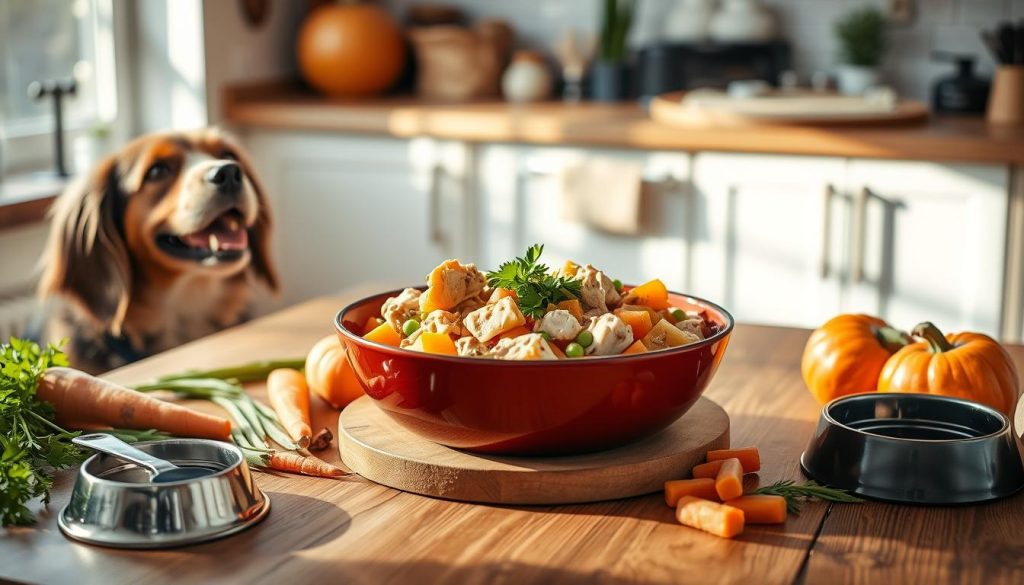
Additional Tips for a Happy, Healthy Pup
Keeping my dog happy and healthy is more than just food. Regular vet visits are key. I schedule annual check-ups to catch health issues early and keep vaccinations current. These vet visits are a top priority for my dog’s health.
Physical exercise is also crucial. We go for daily walks and play together. This keeps my dog fit and strengthens our bond. Activities like fetch or agility training are great for their physical and mental health.
Providing mental stimulation is also important. I give my dog engaging toys and puzzles. These entertain and challenge their mind, just like physical activity. With a balanced lifestyle that includes good food, vet visits, exercise, and mental games, I know I’m doing everything I can for my dog’s happiness and health.

